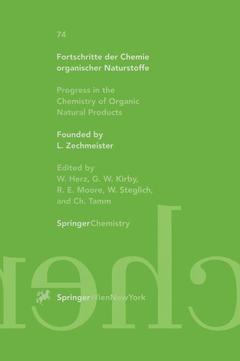Description
Fortschritte der Chemie organischer Naturstoffe / Progress in the Chemistry of Organic Natural Products, 1998
Fortschritte der Chemie organischer Naturstoffe Progress in the Chemistry of Organic Natural Products Series, Vol. 74
Author: Garai S.
Language: English
Subjects for Fortschritte der Chemie organischer Naturstoffe /...:
Keywords
6-dexyamino; Triterpenoid saponin; biochemistry; chemistry; natural product; polymer; sugar; synthesis
Publication date: 10-2012
304 p. · Paperback
304 p. · Paperback
Description
/li>Contents
/li>Comment
/li>
Saponins are complex molecules made up of sugars linked to a triterpenoid or a steroid or a steroidal alkaloid. These natural products are attracting much attention in recent years because of the host of biological activities they exhibit. The diversity of structural features, the challenges of isolation because of their occurrence as complex mixtures, the pharmacological and biological activities still to be discovered, and the prospect of commercialization - these all are driving the study of saponins. Triterpenoid saponins are dominating constituents of this class and occur widely throughout the plant kingdom including some human foods e. g. beans, spinach, tomatoes, and potatoes, and animal feed e. g. alfalfa and clover. Saponins were initially a rather neglected· area of research primarily because of great difficulties in their isolation and characterization. With the advent of more sophisticated methods of isolation and structure elucidation through the last two decades, there has been increased interest in these natural products. Besides structure determination, research activities are now moving forward to clarify structure-activity relationships. Our previous reviews on triterpenoid saponins (l, 2) covered literature from 1979 to mid-1989. The literature on triterpenoid saponins up to 1988 has also been covered by two reviews by HILLER et at. (3, 4). This review incorporates newer trends in isolation and structure determination of triterpenoid saponins, new triterpenoid saponins isolated and biological properties of these products reported during the period late 1989-mid 1996. 2.
Triterpenoid Saponins.- 1. Introduction.- 2. Isolation.- 3. Structure Elucidation.- 3.1. Mass Spectroscopy.- 3.2. NMR Spectroscopy.- 4. Biological Activity.- 4.1. Antifungal Activity.- 4.2. Immunomodulatory Activity.- 4.3. Molluscicidal Activity.- 4.4. Spermicidal Activity.- 4.5. Hypoglycemic Activity.- 4.6. Antitumor Activity.- 4.7. Hypocholesterolemic Effect.- 4.8. Antiaging Effect.- 4.9. Cardiovascular Activity.- 4.10. Antiviral Activity.- 4.11. Antisweet Activity.- 4.12. Analgesic Activity.- 4.13. Antileishmanial Activity.- 4.14. Miscellaneous Effects.- 5. Production of Saponins by Tissue Culture.- 6. Future Possibilities.- 7. Reports of New Triterpenoid Saponins.- Acknowledgements.- References.- Synthesis of 6-Deoxyamino Sugars.- 1. Introduction.- 1.1. General.- 1.2. Antibiotics.- 2. Known 6-Deoxyaminohexoses.- 3. Synthetic Aspects.- 3.1. Carbohydrates as Starting Materials.- 3.1.1. Monoamino Dideoxyhexoses.- 3.1.2. Monoamino Trideoxyhexoses.- 3.1.3. Monoamino Tetradeoxyhexoses.- 3.2. Non-Carbohydrates as Starting Materials.- 3.2.1. Monoamino Dideoxyhexoses.- 3.2.2. Monoamino Trideoxyhexoses.- 3.2.3. Monoamino Tetradeoxyhexoses.- References.- Author Index.
Source of information for experts and a means of orientation for non-experts * Contributions on various classes of naturally occurring substances ranging from small molecules to biopolymers
© 2024 LAVOISIER S.A.S.
These books may interest you

Handbook of TerpenoidsVolume II 365.50 €



